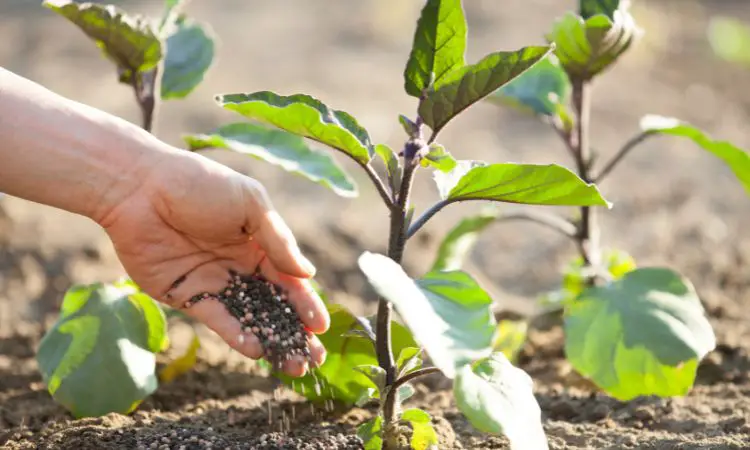Fertilizer does something super important for grass – it gives it essential nutrients that make it strong and happy. The special stuff in fertilizer is called nitrogen, phosphorus, and potassium, and these are like magic for the grass.
They help the grass to turn a beautiful green, make its roots grow strong, and even help it fight off bad stuff that can make it sick.
When you sprinkle fertilizer on your lawn, you’re giving your grass a superhero boost.
It grows lush and green, becomes tough against diseases, heals from all the running and mowing, and even invites tiny bugs in the soil to come and have a party.
That’s how fertilizer gives your grass the power to become thick and strong.
However, a well-maintained lawn adds beauty and value to any residential or commercial property. One key element of lawn care is ensuring that the grass receives the necessary nutrients to thrive.
Fertilizer plays a vital role in promoting healthy grass growth and maintaining a vibrant lawn.
A properly fertilized lawn not only looks lush and green but also provides a comfortable space for activities and enhances curb appeal.

Credit: fertilizerboosters.com
Why Is It Important to Fertilize For Grass Growth?
Fertilizer plays a vital role in promoting healthy grass growth by providing essential nutrients and minerals.
It enhances root development, improves color and texture, and helps the grass withstand environmental stressors, resulting in a lush and vibrant lawn.
The grass is truly the backbone of any beautiful and vibrant lawn. To achieve that lush green carpet, it’s important to understand the role of fertilizer in sustaining healthy grass growth.
Nutrients required by grass for healthy growth:
Nitrogen: This essential nutrient helps promote leaf and stem growth, giving your grass that vibrant green color. Nitrogen makes up 0.002% of the Earth’s crust. It’s the most abundant gas in the Earth’s atmosphere, making up 78.1% of it.
Phosphorus:
Phosphorus is super important for plant roots to grow strong and healthy. It makes sure your grass is tough and can stand up to the weather. In the springtime, grass really needs phosphorus to grow well.
If there’s not enough of it, the grassroots won’t be strong enough and might get carried away by the rain.
It’s best to have about 25 to 50 parts per million (ppm) of phosphorus in the soil, and the University of Nebraska-Lincoln says it’s a good idea to add a bit of phosphorus every year to keep it in that range.
Potassium:
Potassium, or as some folks call it, potash, is like a super-nutrient for plants. It’s like a plant bodyguard, helping them fight off bad stuff like drought, fungus, winter chills, scorching sun, too much water, and even super bright light.
Potassium is also good for water, helping plants drink just the right amount, so they don’t get too puffed up or wilted. This special nutrient is superabundant in the Earth’s crust, and is everywhere, about 2.1 to 2.3% of it.
And where can we find it for our plant pals? Well, you can dig it up from rocks, use wood ash, throw in some manure or compost, or even get some fancy-sounding Muriate of Potash (MOP). MOP is like the boss of the potash world and it’s usually got 60% K2O inside.

How Fertilizer Provides These Essential Nutrients?
Fertilizers are like superfoods for plants, made from nature’s very own elements: nitrogen, potassium, and phosphate. Think of these nutrients as the secret recipe for turning tired soil into a fertile playground for plants to grow.
Nitrogen-based fertilizers are like the building blocks of proteins.
You know, those things that help plants grow big and strong.
When you use these fertilizers, they stick to the plant’s roots like glue, and when it rains, they dissolve and deliver a big burst of nitrogen, making plants really happy.
Potassium-based fertilizers are like the plant’s personal thermostat.
They control little doors called stomata, which decide how much water vapor, oxygen, and carbon dioxide can come and go.
Potassium also fights off bad plant diseases and makes fruits and veggies even tastier.
Phosphorus-rich fertilizers:
When your garden needs a boost, think about using fertilizers with lots of phosphorus. They’re like key food for roots, helping plants stay strong against icky stuff like diseases, drought, and tough weather.
Phosphorus is a real MVP for plants that want to make flowers or yummy fruits. It’s also a coach for root development, teaching them to grow big and strong.
These special fertilizers are made in different ways, like mixing ground-up rock with sulfuric acid, turning rock into triple superphosphate, or treating minerals with acids.
Phosphorus treats for plants can come from all kinds of places, like digging up phosphate rock from the Earth, or even using things like animal manure, bone meal, sewage stuff, and even leftover food.
When these fertilizers meet water, they share a little plant snack with the soil. It’s like a secret handshake between the plant and the nutrients!
And hey, don’t forget about other cool phosphorus sources like coffee grounds and bone meal.
Here’s a list to help you remember the good stuff:
Phosphorus-rich fertilizers source:
- Ground-up rock + Sulfuric acid mix
- Triple superphosphate from rock
- Treating minerals with acids
- Phosphate rock (dug up from the ground)
- Animal or human manure/waste
- Bone meal
- Sewage sludge
- Slaughterhouse waste
- Food waste
- Coffee grounds
What happens when plants are nutrient deficient?
Grass needs three important things to grow strong and healthy: nitrogen, phosphorus, and potassium. These nutrients help with things like making roots strong, stems sturdy, and leaves a bright green color.
If grass doesn’t get these nutrients, it won’t grow well, and it might get sick and eventually die.
Some things that show your grass needs more of these nutrients are when it turns a pale green or yellow color all over or in patches, and when yellow lines show up next to the veins in the leaves.
It might also look weak, with yellow or bleached spots, and the leaf tips might curl up and turn yellow between the veins.
There can even be dead spots on the edges of the leaves. If grass doesn’t get these nutrients for a long time, it can become thin and not look so good.
Also Read: Are Dead Leaves Good For Soil? (Informed Stat)
The same kind of problems can happen with other plants too, like when their leaves turn purple or yellow on the bottom.

How Does Fertilizer Affect Grass Pigmentation?
Three main nutrients in fertilizer affect the color of the grass. Nitrogen is like a painter; it helps the grass make chlorophyll, the green color.
Phosphorus helps the roots grow strong, so they can take in more nutrients for a better color. Potassium keeps the grass healthy, which means it can stay green.
To pick the right fertilizer, first, you should check the soil with a soil test to see what your grass needs. If you want your grass to look extra green, look for a fertilizer with more nitrogen.
It’s like getting extra paint for your grass. Slow-release fertilizers are like a slow drip of food for your grass, keeping it green for a long time.
A balanced fertilizer with the right mix of nitrogen, phosphorus, and potassium will keep your grass looking great.
| Consideration | Recommendation |
| Soil Test | Conduct a soil test to determine specific needs |
| Nitrogen Ratio | Look for a higher nitrogen ratio in fertilizer |
| Slow-release Formulas | Opt for slow-release fertilizers for consistent color |
| Balanced NPK | Choose a balanced NPK ratio for optimal nutrients |
To keep your grass the same color all year, you should change how much fertilizer you give it based on the season.
In the growing season, give it more.
- Water your grass enough, but not too much, or it will lose the good stuff.
- Mow the grass at the right height to keep it happy and cut off the weeds to make sure your grass gets all the food and water it needs.
How Fertilizer Stimulates Root Growth?
Fertilizer helps in boosting root growth in plants. The nutrients are like the vitamins for plants, helping them to grow better, yield more, and stay healthier.
Moreover, fertilizers often contain special plant hormones known as auxins, which are like the plant’s helpers.
Auxins do many important things: they encourage tiny creatures in the soil to work their magic, making sure there’s plenty of oxygen and water for the roots.
They also tell the plant when it’s time to grow more roots, and they are in charge of making cells grow and divide in the plant.
Phosphorus and potassium in fertilizers are super important during the growing season. Phosphorus helps roots and fruit, while potassium fights off diseases and toughens up the plant.
Frequently Asked Questions For What Does Fertilizer Do For Grass
When Should I Apply Fertilizer to My Lawn?
Fertilize your lawn during its active growth periods. For cool-season grasses, that means in spring and/or fall, while warm-season grasses respond best to fertilization in late spring and early summer.
Avoid fertilizing during a drought, as most fertilizers require adequate watering to penetrate the soil.
Applying fertilizer without proper watering can harm the grass, so consider postponing the application until there’s sufficient moisture.
Does Fertilizer Strengthen Grass?
Yes, fertilizer can enhance the strength of your grass. Fertilizer contains essential nutrients like nitrogen, phosphorus, and potassium, which support robust root development and vibrant green grass.
Fertilizing your lawn can result in various benefits, such as promoting strong, healthy growth, denser grass, improved resistance to drought, enhanced root systems, increased chlorophyll production, and better endurance against adverse conditions.
Neglecting to fertilize can deprive the soil of necessary nutrients, leading to weak turf growth and increased susceptibility to weeds and pests.
You can fertilize in spring and even during the summer for continued growth in slightly cooler temperatures.
How Often Should I Fertilize My Lawn?
It’s advisable to fertilize your lawn every 6-8 weeks, with a total of three to five applications during the growing season.
If you have an automatic sprinkler system, a six-week interval is suitable, while those without one can wait an additional two weeks between applications.
Proper and consistent fertilization helps maintain a healthy and vibrant lawn.
Sum Up,
Overall, Fertilizer is a vital tool for a healthy lawn. It provides essential nutrients like nitrogen, phosphorus, and potassium, making your grass strong, resilient, and visually appealing. However, proper application is crucial to avoid over-fertilization, which can harm the environment.

I am a graduate of Bangladesh Agricultural University, where I delved into various agricultural disciplines, equipping me with a profound understanding of agriculture. Beyond academics, I have hands-on experience in gardening and crop cultivation. My passion is to embrace sustainable farming and horticulture. With a BSc in Agriculture, I am dedicated to promoting environmentally conscious and efficient agrarian practices.
Bachelor of Science (BSc) in Agriculture (Hons.)
Master of Science. (Sustainable Agriculture & Food Security ) (MS)
Bangladesh Agricultural University



